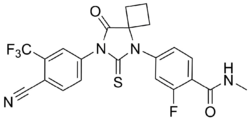Chemistry:RD-162
 | |
| Clinical data | |
|---|---|
| Routes of administration | By mouth |
| Drug class | Nonsteroidal antiandrogen |
| Identifiers | |
| |
| CAS Number | |
| PubChem CID | |
| ChemSpider | |
| UNII | |
| ChEMBL | |
| Chemical and physical data | |
| Formula | C22H16F4N4O2S |
| Molar mass | 476.45 g·mol−1 |
| 3D model (JSmol) | |
| |
| |
RD-162 is a second-generation nonsteroidal antiandrogen (NSAA) which was developed for the treatment of prostate cancer but was never marketed.[1] It acts as a potent and selective silent antagonist of the androgen receptor (AR).[1] The drug is a diarylthiohydantoin derivative.[1] It is closely related to enzalutamide and apalutamide.[1] Both RD-162 and enzalutamide show 5- to 8-fold higher affinity for the AR than the first-generation NSAA bicalutamide, and only 2- to 3-fold lower affinity than dihydrotestosterone (DHT), the major endogenous ligand of the receptor in the prostate gland.[1]
RD-162 and enzalutamide were developed together and were derived from the nonsteroidal androgen RU-59063, which itself was derived from the first-generation NSAA nilutamide.[2] RD-162 and enzalutamide were selected as the lead compounds from a group of over 200 compounds that were synthesized and assayed for antiandrogenic activity.[1] Enzalutamide was ultimately selected from the two for further clinical development and was eventually marketed.[1] RD-162 is also very closely related to apalutamide, with the two compounds differing only by the replacement of a single atom (a carbon atom in one of the phenyl rings of RD-162 swapped with a nitrogen atom in apalutamide). Apalutamide was approved for the treatment of prostate cancer in 2018.[3]
References
- ↑ 1.0 1.1 1.2 1.3 1.4 1.5 1.6 "Development of a second-generation antiandrogen for treatment of advanced prostate cancer". Science 324 (5928): 787–90. 2009. doi:10.1126/science.1168175. PMID 19359544. Bibcode: 2009Sci...324..787T.
- ↑ "Developments in nonsteroidal antiandrogens targeting the androgen receptor". ChemMedChem 5 (10): 1651–61. 2010. doi:10.1002/cmdc.201000259. PMID 20853390.
- ↑ "Apalutamide - Janssen Research and Development - AdisInsight". http://adisinsight.springer.com/drugs/800032695.
 |

